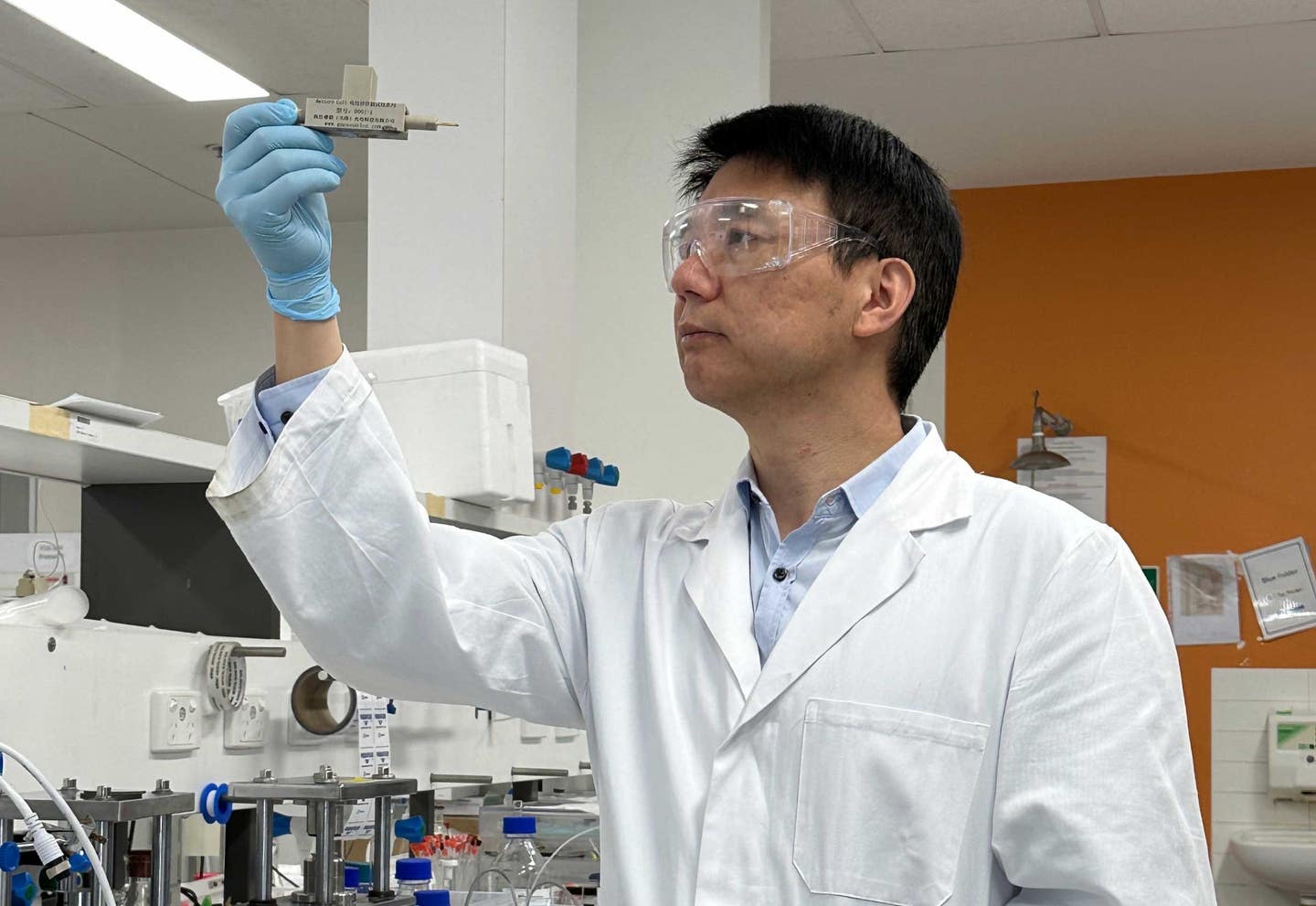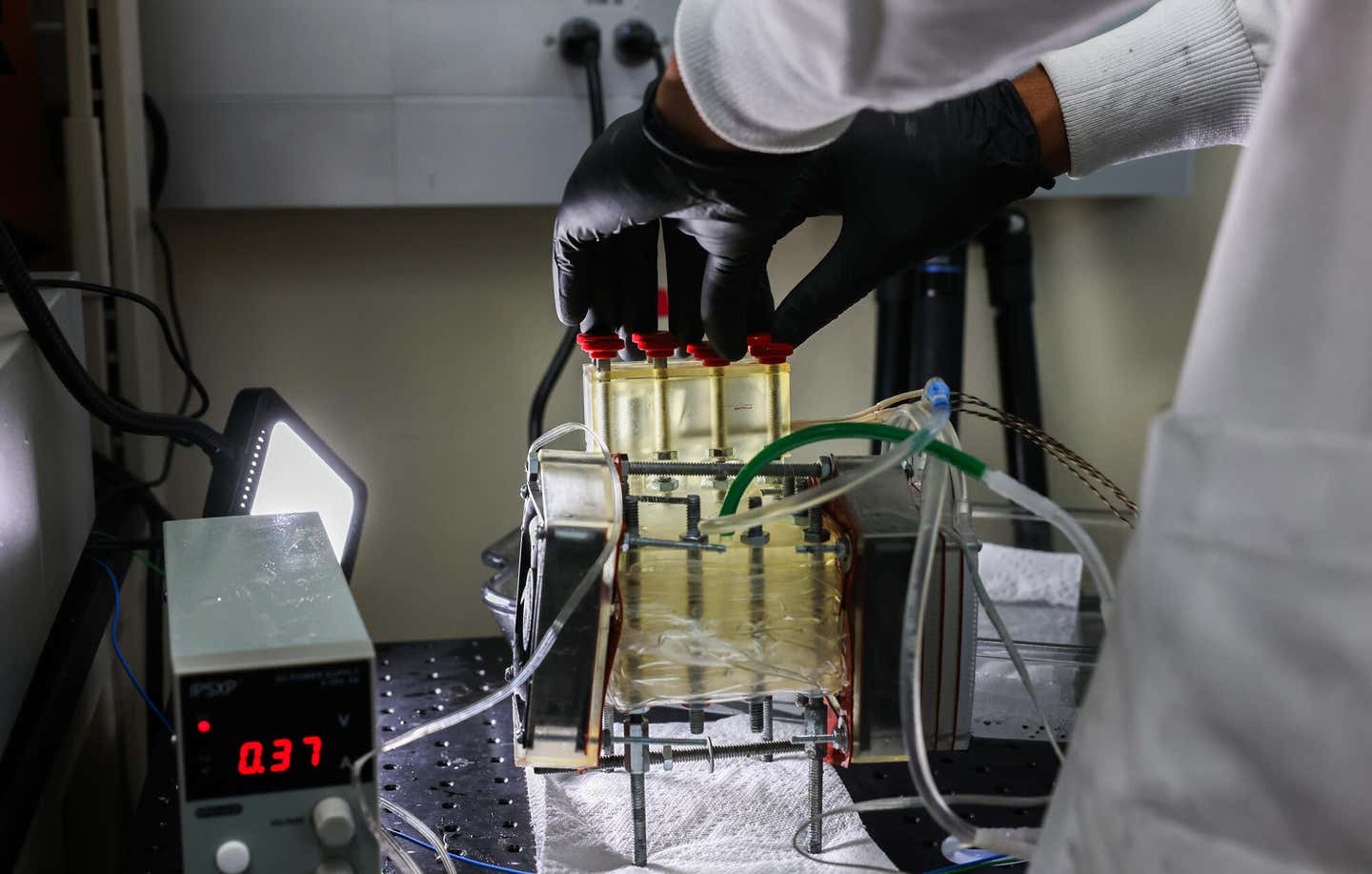Proton batteries offer safer, faster charging than lithium-ion
Discover how proton battery technology offers safer, affordable, and efficient renewable energy storage, outperforming lithium-ion batteries.

Professor Chuan Zhao holds up a prototype of a proton battery in the lab, made in collaboration with UNSW Engineering and ANSTO. (CREDIT: UNSW)
As the world moves toward renewable energy, there's a growing need for effective ways to store electricity. Renewable sources, like solar and wind, only produce power intermittently, making reliable storage crucial. One promising solution gaining attention is proton-based battery technology.
Lithium-ion batteries currently dominate the market. They're found in almost every portable electronic device, from smartphones and laptops to electric vehicles. Yet, these batteries come with significant drawbacks. Producing lithium batteries consumes vast amounts of water and energy, and they're notoriously challenging to recycle. Additionally, lithium isn't plentiful everywhere, causing geopolitical and economic concerns.
A new type of battery using protons—the smallest, lightest ions—has emerged as an exciting alternative. Proton batteries avoid the environmental and resource issues tied to lithium.
Scientists have recently developed a rechargeable proton battery made entirely from organic materials. This battery performs exceptionally well, storing energy effectively at room temperature and even under freezing conditions.
Why Proton Batteries Matter
A significant advantage of proton batteries is how fast they charge. Unlike lithium-ion batteries, protons move rapidly through the battery because they're extremely small and lightweight. Scientists describe proton movement through a unique mechanism called the "Grotthuss mechanism," which transfers protons efficiently without significant mass changes in battery electrodes. This means proton batteries can achieve impressively quick charging times and function effectively even at extreme temperatures.
“There are many benefits to proton batteries,” said Sicheng Wu, a scientist from UNSW Chemistry, involved in this new battery's development. “Lithium is a finite resource not evenly distributed, and lithium batteries struggle with fast charging, safety, and performance in cold temperatures.”
Wu explained further, “To enhance renewable energy use, we need more efficient energy storage technologies. Our proton battery is a promising trial.”
Related Stories
Organic Compounds: The Secret Ingredient
To harness the potential of proton batteries, researchers have explored various electrode materials. Most traditional metal-ion batteries rely on heavy metal electrodes, but proton batteries open possibilities for using lighter, organic materials instead. Organic electrodes store protons effectively because their molecular structures can be adjusted through chemical modifications.
Scientists initially tested inorganic materials, such as Prussian-blue compounds and metal oxides. However, these materials tend to degrade quickly, offering limited charge cycles and lower capacities. As an alternative, organic materials have drawn attention.
One organic molecule called pyrene-4,5,9,10-tetraone previously showed promise, delivering capacities up to 408 milliamp-hours per gram and stable cycling over 489 days. Yet, even this compound was overly complicated and not optimal for practical battery use.
To improve performance, researchers turned their attention to simpler, more adaptable organic materials. Recently, a team successfully created an efficient new organic electrode by modifying a common chemical called tetrachloro-benzoquinone (TCBQ).
Although TCBQ was previously tested, its energy storage capabilities weren't strong enough for practical battery use. By replacing chlorine atoms in the molecule with amino groups, scientists transformed TCBQ into tetraamino-benzoquinone (TABQ). This modification significantly boosted proton storage and created an electrode capable of impressive battery performance.
“We developed a novel, high-capacity small-molecule material for proton storage,” explained Professor Chuan Zhao. “Using this material, we successfully built an all-organic proton battery effective at room temperature and sub-zero temperatures.”
Proton Battery Performance: Putting It to the Test
The researchers paired their newly developed TABQ anode with a TCBQ cathode, creating a fully organic battery. During rigorous testing, the proton battery demonstrated excellent results, withstanding over 3,500 full charge-and-discharge cycles without substantial performance loss. This durability greatly surpasses typical inorganic alternatives, which often fail before reaching 1,000 cycles.
Moreover, the proton battery performed impressively in low-temperature conditions, a significant advantage over lithium-ion batteries, which typically struggle below freezing. The key to this robust performance lies in the battery’s electrolyte, which is a simple water solution.
Unlike lithium-ion batteries that use flammable electrolytes, proton batteries’ aqueous electrolytes enhance safety and environmental friendliness.
Professor Zhao explained, “In lithium-ion batteries, the electrolyte consists of lithium salt in a solvent that's flammable—making it risky. Our battery uses organic molecules in both electrodes with water between them, creating a lightweight, safe, and affordable option.”
While acknowledging the current production cost of TABQ, Zhao emphasized that scaling up manufacturing should reduce expenses substantially. He noted, “Because it's made of abundant, lightweight elements, it'll eventually become affordable and easy to scale.”
Potential for Grid-Scale Energy Storage
Grid-scale energy storage is a critical step in adopting renewable energy more widely. Currently, lithium-ion batteries can't economically handle large-scale storage, mostly due to their high cost and safety risks. Proton batteries offer a practical solution to these challenges. Their low production costs, high safety standards, and excellent fast-charging capabilities position them perfectly for widespread use.
Wu explained the broader implications clearly: “We don't yet have suitable solutions for grid-scale storage because using tons of lithium batteries is too expensive and unsafe. Our proton battery design could change that.”
The researchers aren't finished yet. Although they've created a powerful anode, their next goal is to improve the cathode. By further developing organic molecules with even higher energy storage capabilities, the team hopes to boost battery voltage output, making proton batteries even more effective.
Beyond Batteries: Broader Implications of Proton Storage
Beyond battery applications, this discovery also carries broader scientific significance. Proton transfer is fundamental in nature, governing many biological processes, including energy production in humans and plants. Understanding and improving proton transport mechanisms can therefore benefit multiple fields.
Professor Zhao described additional potential: “Proton transport is essential in nature, from the human body to plants. These organic molecules could help store and transport hydrogen safely and effectively.”
Currently, hydrogen storage faces significant challenges because molecular hydrogen is difficult and dangerous to transport. However, if hydrogen is stored as protons, it becomes much safer and more stable, simplifying global distribution. This breakthrough could revolutionize the hydrogen industry, providing an effective way to transport hydrogen internationally, extracting it wherever needed.
Zhao concluded enthusiastically, “Our discovery has made this concept a possible reality.”
As proton battery research progresses, it offers promising answers to global energy challenges, paving the way for sustainable and efficient energy storage solutions.
Research findings can be found in the journal Angewandte Chemie.
Note: The article above provided above by The Brighter Side of News.
Like these kind of feel good stories? Get The Brighter Side of News' newsletter.
Joseph Shavit
Head Science News Writer | Communicating Innovation & Discovery
Based in Los Angeles, Joseph Shavit is an accomplished science journalist, head science news writer and co-founder at The Brighter Side of News, where he translates cutting-edge discoveries into compelling stories for a broad audience. With a strong background spanning science, business, product management, media leadership, and entrepreneurship, Joseph brings a unique perspective to science communication. His expertise allows him to uncover the intersection of technological advancements and market potential, shedding light on how groundbreaking research evolves into transformative products and industries.



